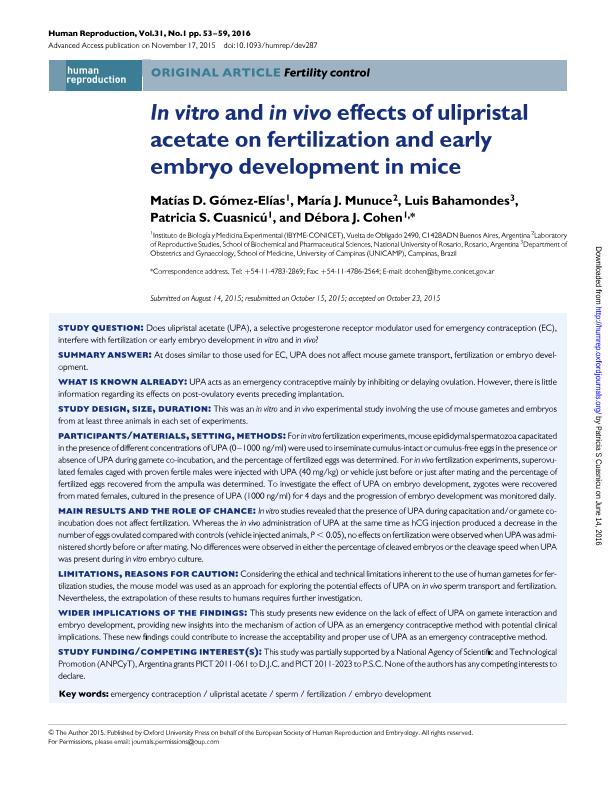Mostrar el registro sencillo del ítem
dc.contributor.author
Gómez Elías, Matías Daniel

dc.contributor.author
Munuce, María José

dc.contributor.author
Bahamondes, Luis
dc.contributor.author
Cuasnicu, Patricia Sara

dc.contributor.author
Cohen, Debora Juana

dc.date.available
2020-08-27T18:31:46Z
dc.date.issued
2016-01
dc.identifier.citation
Gómez Elías, Matías Daniel; Munuce, María José; Bahamondes, Luis; Cuasnicu, Patricia Sara; Cohen, Debora Juana; In vitro and in vivo effects of ulipristal acetate on fertilization and early embryo development in mice; Oxford University Press; Human Reproduction; 31; 1; 1-2016; 53-59
dc.identifier.issn
0268-1161
dc.identifier.uri
http://hdl.handle.net/11336/112582
dc.description.abstract
study question: Does ulipristal acetate (UPA), a selective progesterone receptor modulator used for emergency contraception (EC), interfere with fertilization or early embryo development in vitro and in vivo? summary answer: At doses similar to those used for EC, UPA does not affect mouse gamete transport, fertilization or embryo development. what is known already: UPA acts as an emergency contraceptive mainly by inhibiting or delaying ovulation. However, there is little information regarding its effects on post-ovulatory events preceding implantation. study design, size, duration: This was an in vitro and in vivo experimental study involving the use of mouse gametes and embryos from at least three animals in each set of experiments. participants/materials, setting, methods: Forin vitro fertilization experiments, mouse epididymal spermatozoa capacitated in the presence of different concentrations of UPA (0–1000 ng/ml) were used to inseminate cumulus-intact or cumulus-free eggs in the presence or absence of UPA during gamete co-incubation, and the percentage of fertilized eggs was determined. For in vivo fertilization experiments, superovulated females caged with proven fertile males were injected with UPA (40 mg/kg) or vehicle just before or just after mating and the percentage of fertilized eggs recovered from the ampulla was determined. To investigate the effect of UPA on embryo development, zygotes were recovered from mated females, cultured in the presence of UPA (1000 ng/ml) for 4 days and the progression of embryo development was monitored daily. main results and the role of chance: In vitro studies revealed that the presence of UPA during capacitation and/or gamete coincubation does not affect fertilization. Whereas the in vivo administration of UPA at the same time as hCG injection produced a decrease in the number of eggs ovulated compared with controls (vehicle injected animals, P , 0.05), no effects on fertilization were observed when UPAwas administered shortly before or after mating. No differences were observed in either the percentage of cleaved embryos or the cleavage speed when UPA was present during in vitro embryo culture. limitations, reasons for caution: Considering the ethical and technical limitations inherent to the use of human gametes for fertilization studies, the mouse model was used as an approach for exploring the potential effects of UPA on in vivo sperm transport and fertilization. Nevertheless, the extrapolation of these results to humans requires further investigation. wider implications of the findings: This study presents new evidence on the lack of effect of UPA on gamete interaction and embryo development, providing new insights into the mechanism of action of UPA as an emergency contraceptive method with potential clinical implications. These new findings could contribute to increase the acceptability and proper use of UPA as an emergency contraceptive method. study funding/competing interest(s): This study was partially supported by a National Agency of Scientific and Technological Promotion (ANPCyT), Argentina grants PICT 2011-061 to D.J.C. and PICT 2011-2023 to P.S.C. None of the authors has any competing interests to declare.
dc.format
application/pdf
dc.language.iso
eng
dc.publisher
Oxford University Press

dc.rights
info:eu-repo/semantics/openAccess
dc.rights.uri
https://creativecommons.org/licenses/by-nc-sa/2.5/ar/
dc.subject
EMBRYO DEVELOPMENT
dc.subject
EMERGENCY CONTRACEPTION
dc.subject
FERTILIZATION
dc.subject
SPERM
dc.subject
ULIPRISTAL ACETATE
dc.subject.classification
Biología Reproductiva

dc.subject.classification
Ciencias Biológicas

dc.subject.classification
CIENCIAS NATURALES Y EXACTAS

dc.title
In vitro and in vivo effects of ulipristal acetate on fertilization and early embryo development in mice
dc.type
info:eu-repo/semantics/article
dc.type
info:ar-repo/semantics/artículo
dc.type
info:eu-repo/semantics/publishedVersion
dc.date.updated
2020-08-24T18:08:02Z
dc.journal.volume
31
dc.journal.number
1
dc.journal.pagination
53-59
dc.journal.pais
Reino Unido

dc.journal.ciudad
Oxford
dc.description.fil
Fil: Gómez Elías, Matías Daniel. Consejo Nacional de Investigaciones Científicas y Técnicas. Instituto de Biología y Medicina Experimental. Fundación de Instituto de Biología y Medicina Experimental. Instituto de Biología y Medicina Experimental; Argentina
dc.description.fil
Fil: Munuce, María José. Universidad Nacional de Rosario. Facultad de Ciencias Bioquímicas y Farmacéuticas; Argentina
dc.description.fil
Fil: Bahamondes, Luis. Universidade Estadual de Campinas; Brasil
dc.description.fil
Fil: Cuasnicu, Patricia Sara. Consejo Nacional de Investigaciones Científicas y Técnicas. Instituto de Biología y Medicina Experimental. Fundación de Instituto de Biología y Medicina Experimental. Instituto de Biología y Medicina Experimental; Argentina
dc.description.fil
Fil: Cohen, Debora Juana. Consejo Nacional de Investigaciones Científicas y Técnicas. Instituto de Biología y Medicina Experimental. Fundación de Instituto de Biología y Medicina Experimental. Instituto de Biología y Medicina Experimental; Argentina
dc.journal.title
Human Reproduction

dc.relation.alternativeid
info:eu-repo/semantics/altIdentifier/doi/http://dx.doi.org/10.1093/humrep/dev287
dc.relation.alternativeid
info:eu-repo/semantics/altIdentifier/url/https://academic.oup.com/humrep/article/31/1/53/2380219
Archivos asociados
